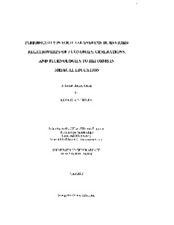| dc.creator | Kinra, Reva Elaine | |
| dc.date.accessioned | 2013-02-22T20:39:52Z | |
| dc.date.available | 2013-02-22T20:39:52Z | |
| dc.date.created | 2002 | |
| dc.date.issued | 2013-02-22 | |
| dc.identifier.uri | https://hdl.handle.net/1969.1/ETD-TAMU-2002-Fellows-Thesis-K486 | |
| dc.description | Due to the character of the original source materials and the nature of batch digitization, quality control issues may be present in this document. Please report any quality issues you encounter to digital@library.tamu.edu, referencing the URI of the item. | en |
| dc.description | Includes bibliographical references (leaves 20-21). | en |
| dc.description.abstract | As medical educators strive to produce qualified physicians who are able to meet societal needs, the medical education system must continually reform itself to meet the demands of that changing society. Understanding the interactions between medical education and surrounding societal behaviors is essential for improvement of the medical education process. Reforms in medical education provide for constructive adaptation in the educational system's process, content, and organization. Three societal systems that impact medicine and medical education include economics, generations, and technology. Change occurs periodically within these systems, producing cyclical or pulsatile patterns of behavior. Numerous studies have analyzed generational cycles to describe changes in dominant attitudes and values (Strauss and Howe, Schlesinger), economic waves to describe behavior of economies (Arrighi, Screpanti), and invention-innovation cycles to describe patterns in technological advancement (Devezas, Marchetti). In seeking to discover how medical education responds to such societal changes, this research analyzes past educational reforms in the context of concurrent social environments. By discovering temporal connections between cyclical behaviors of societal systems and specific reforms in medical education, putative cause and effect relationships may be proposed. As social systems repeat their behaviors, knowledge of medical education's past responses can shed light on current interactions. This type of information can support educators and decision-makers responsible for cultivating medical educational institutions and medical curricula. | en |
| dc.format.medium | electronic | en |
| dc.format.mimetype | application/pdf | |
| dc.language.iso | en_US | |
| dc.publisher | Texas A&M University | |
| dc.rights | This thesis was part of a retrospective digitization project authorized by the Texas A&M University Libraries in 2008. Copyright remains vested with the author(s). It is the user's responsibility to secure permission from the copyright holder(s) for re-use of the work beyond the provision of Fair Use. | en |
| dc.subject | health and education. | en |
| dc.subject | Major health and education. | en |
| dc.title | Periodicities in societal systems behaviors: relationships of economies, generations, and technologies to reforms in medical education | en |
| thesis.degree.department | health and education | en |
| thesis.degree.discipline | health and education | en |
| thesis.degree.name | Fellows Thesis | en |
| thesis.degree.level | Undergraduate | en |
| dc.type.genre | thesis | en |
| dc.type.material | text | en |
| dc.format.digitalOrigin | reformatted digital | en |


